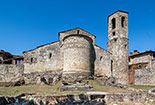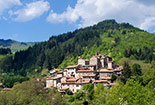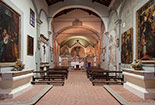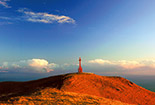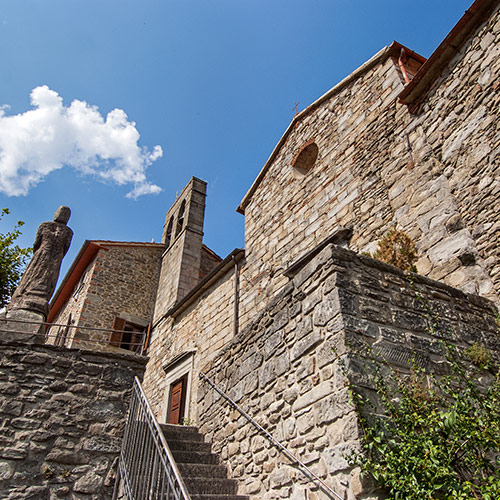Rassina and the Focognano's Castle
in Casentino, a Tuscan valley with which you can get familiar in every detail through this site
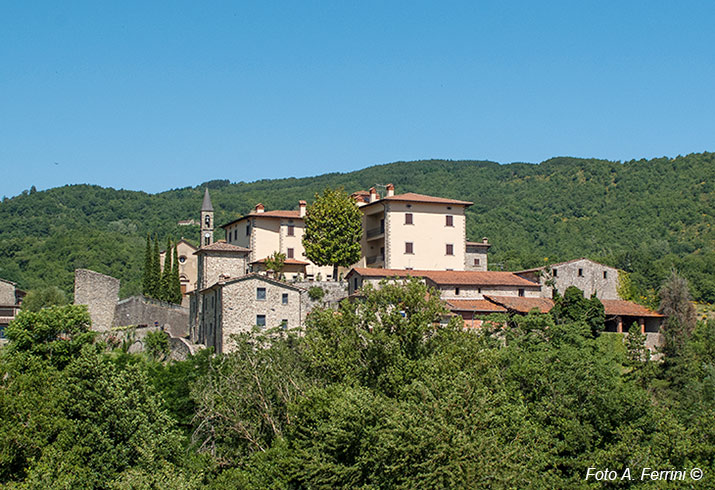
Texts and photos by Alessandro Ferrini ©
66 images in sequence of Castel Focognano. Click to enlarge
Rassina and Castel Focognano, two very different villages
 Rassina is the seat of the Municipality of Castel Focognano, a small village four kilometres away on the road that climbs towards Pratomagno. The village became such in 1778 by decree of the Grand Duke of Tuscany, Pietro Leopoldo, who considered Castel Focognano too dislocated and uncomfortable to carry out the administrative functions of a territory that was developing demographically and economically. Rassina represented the fulcrum of this development, also because the town was placed on the road that connected Arezzo with the Casentino.
Rassina is the seat of the Municipality of Castel Focognano, a small village four kilometres away on the road that climbs towards Pratomagno. The village became such in 1778 by decree of the Grand Duke of Tuscany, Pietro Leopoldo, who considered Castel Focognano too dislocated and uncomfortable to carry out the administrative functions of a territory that was developing demographically and economically. Rassina represented the fulcrum of this development, also because the town was placed on the road that connected Arezzo with the Casentino.
The toponym Rassina is Etruscan and of great lustre. It comes from Rasna or Rasenna, the name by which this people defined itself. The country does not have to show us things of particular historical importance. In medieval times the place belonged to the Counts Catani of Chiusi della Verna, later it was the Ubertini and then the Tarlati. Testimonies of his past are two towers. One is called the Castle of Rassina, but it is reduced to a few ruins. The other is called the Tower of Bellavista for the beautiful view it offers. It has been recently restored and is located high up in the fields, in the southern part of the country. It can be reached by car or on foot through the cemetery area. These towers were used by the feudal lords to control this part of the Arno valley.
In 1385 the whole area came under the jurisdiction of the Florentine Republic. In 1440 Rassina was subjected to damage and looting by Niccolò Piccinino who was going to fight the famous Battle of Anghiari where he would be defeated by the Florentines. In 1502 Rassina was almost completely destroyed by the troops of Vitellozzo Vitelli. Also for these reasons the oldest part of the country is no longer existing.
Since the mid-eighteenth century, the place has experienced an acceleration in terms of trade and production. (since the Middle Ages it was known as a point of trade). But the boom comes in the twentieth century with the construction of a large spinning mill that in the 50s will turn into a factory Lebole and birth in the same years of a large cement factory that if it is not ideal from the point  of view of the environment and landscape, a lot of work has given people in the area.
of view of the environment and landscape, a lot of work has given people in the area.
The hamlet and the church of Rassina date back to the 19th century and represent the oldest part of the place. The Town Hall dates back to the last decades of this century with its large loggia overlooking the main square (Piazza Mazzini). The town has always been associated with a large bridge that crosses the Arno. Along this river you can take a nice walk, or ride, on a cycle/pedestrian path that goes to Bibbiena.
From Rassina we go to visit Castel Focognano after passing by the parish church of Socana that we can know in every detail with this web section.
Castel Focognano is one of the oldest castles of Casentino because we find it already mentioned in 1022. This place still makes us feel a bit of medieval atmosphere. In fact, upon arrival in the old part of the small village, we are greeted by the ancient tower of the castle patrol. We can also breathe in the small loggia of the Palazzo del Podestà dating back to the early fifteenth century.
The Focognano's Castle was built by the Bishops of Arezzo who made it one of their outposts in Casentino. From the second half of the XII century until 1385 this fortified place was property of the powerful Ubertini family. With the exception of a few years, when in 1322 Bishop Guido Tarlati, after a long siege, destroyed and burned Castel Focognano. This disastrous event is remembered by a sculpture in the Guido Tarlati cenotaph in the Cathedral of Arezzo. The power of the Tarlati did not last long and after a few years the castle returned to the hands of the Ubertini. In 1385 the Florentine Republic subjugated all this territory leaving, however, to the Ubertini the administration of the former castle. The noble family was then expelled in 1404, when the Florentines began to administer the territory directly through the vicars. It is the beginning of the period of the podestà, it is the beginning of the period of the reconstruction of Castel Focognano that will last for centuries and will give the place those architectural characteristics that today we can observe. The first building to be built was the Palazzo del Podestà. This and the adjacent loggia, with the many coats of arms present, are the most interesting historical features to see. But the village also shows us characteristic alleys, a beautiful square, large and elegant mansions in its highest part. Then we can observe a pleasant order, a sign of attentive inhabitants and "lovers" of the place, which makes a visit to the country really pleasant. Castel Focognano also offers a beautiful and wide panoramic view around it. Both towards the mountain areas and towards the bottom of the valley. If this were not the case, they would not have built a castle there around the year 1000.
The first building to be built was the Palazzo del Podestà. This and the adjacent loggia, with the many coats of arms present, are the most interesting historical features to see. But the village also shows us characteristic alleys, a beautiful square, large and elegant mansions in its highest part. Then we can observe a pleasant order, a sign of attentive inhabitants and "lovers" of the place, which makes a visit to the country really pleasant. Castel Focognano also offers a beautiful and wide panoramic view around it. Both towards the mountain areas and towards the bottom of the valley. If this were not the case, they would not have built a castle there around the year 1000.
From the village, continuing the road to the mountain, in about nine kilometers we reach Carda, a mountain village with ancient history. If, on the other hand, we return to the valley floor, once we reach the provincial road, turning right we reach Salutio, another hamlet in the municipality of Castel Focognano, in four kilometres. Both these villages have an important art to show inside their ancient churches.



